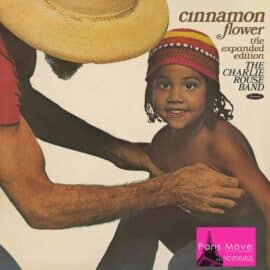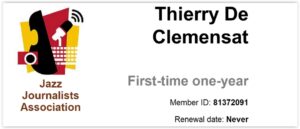| World Jazz |

Charlie Rouse’s “Cinnamon Flower: The Expanded Edition”, A Timeless Testament to a Tenor Giant.
When we speak of Charlie Rouse, we are speaking of a legend, an artist so forward-thinking, so singular in his voice, that even now, nearly four decades after his passing, his music retains the vitality, freshness, and ingenuity of something created today. Though Cinnamon Flower was recorded in 1977, its digital restoration is so pristine, so respectful of the original tapes, that one only senses its vintage through a few sonic cues; otherwise, it could easily be mistaken for a modern release. The reissue of this album is not merely an archival curiosity, it is a revelation, a long-overdue rediscovery of one of the most formidable tenor saxophonists of the 20th century.
Best known for his tenure as the principal saxophonist in Thelonious Monk’s legendary quartet from 1959 to 1970, Rouse was an artist’s artist, highly respected among peers, yet known mostly to discerning jazz connoisseurs. His name may never have achieved the household recognition of a Coltrane or a Rollins, but among those who understood the language of bebop and hard bop, Charlie Rouse was considered a master of tone, nuance, and rhythmic daring.
Cinnamon Flower stands apart from his more straight-ahead sessions, embracing a Brazilian jazz fusion aesthetic that allows Rouse to explore the full range of his expressiveness. The result is a kind of world-jazz mosaic, part samba dream, part post-bop meditation, infused with a lyricism and fluidity that reflect Rouse’s deep musical wisdom. While his sound is unmistakably present, this is a different Rouse—gentler in approach, perhaps, but no less profound.
Before his decades-defining work with Monk, Rouse had already built an extraordinary résumé: playing with the big bands of Billy Eckstine (1944), Dizzy Gillespie (1945), Duke Ellington (1949–50), and Count Basie (1950); recording with Tadd Dameron in 1947; working alongside Clifford Brown in 1953; and contributing to Oscar Pettiford’s seminal sextet in 1955. He co-led the adventurous Jazz Modes group with French horn player Julius Watkins from 1956 to 1959, before cementing his legacy in the Monk ensemble that would define his career for many.
This deluxe edition of Cinnamon Flower, released nearly 50 years after the original, is a triumph of curation and preservation. Resonance Records, renowned for its meticulous archival work—presents this as the definitive version: a 2-LP, 180-gram limited edition set (also available in deluxe CD format), featuring nearly 30 minutes of previously unreleased material. All of it was captured by Resonance founder and engineer George Klabin at New York’s Sound Ideas Studio. The remastering, carried out by Matthew Lutthans at The Mastering Lab, ensures that every nuance of Rouse’s playing is rendered with astonishing clarity.
Among the new offerings is “Meeting House,” a track not found on any prior Rouse album, which alone justifies the price of admission. Liner notes by acclaimed author James Gavin, as well as a touching contribution from Rouse’s son, Charlie “Chico” Rouse Jr., provide rich context to the man and the moment.
This is more than a reissue. It is an invitation, to younger generations of musicians, to scholars of jazz history, and to curious listeners eager to experience the fusion of melodic sophistication and rhythmic ease. It’s a reminder of what happens when technical brilliance meets unbounded imagination. And for those jazz lovers who still crave the thrill of discovery, Cinnamon Flower: The Expanded Edition is an essential listen, an album that surprises, delights, and resonates deeply, across both time and genre.
Thierry De Clemensat
Member at Jazz Journalists Association
USA correspondent for Paris-Move and ABS magazine
Editor in chief – Bayou Blue Radio, Bayou Blue News
PARIS-MOVE, August 2nd 2025
Follow PARIS-MOVE on X
::::::::::::::::::::::::
https://www.youtube.com/watch?v=CBG7ZLDo1n4
Musicians:
Charlie Rouse – tenor saxophone
Clifford Adams – trombone
Claudio Roditi, Waymon Reid – trumpet
Lou Orenstein – flute
Dom Salvador – piano, Fender Rhodes
Albert Dailey – electric piano
Ted Dunbar, George Davis – electric guitar
Amaury Tristão – acoustic guitar
Jesse Levy, Ulysses Kirksey – cello
Wilbur Bascomb, Ron Carter – bass
Portinho, Bernard Purdie – drums
Carlos Martinez, Steve Thornton – percussion
Roger Powell – string synthesizer
Tracking List:
Side A – The Original Album
1. Backwoods Echo (Sertão) – 5:13 – D. Salvador / Editions Douglas, Rick’s Music Inc. (BMI)
2. Disenchantment (Desencontro) – 3:53 – T. Amaury, M. Telles / Tristao Music (BMI)
3. A New Dawn (Alvorada) – 5:46 – T. Amaury / Tristao Music (BMI)
4. Quiet Pictures (Natal No Interior) – 4:08 – D. Salvador / Mr. Bongo (PRS), Sounds Big International (ASCAP)
Side B – The Original Album
1. Clove and Cinnamon (Cravo E Canela) – 5:44 – M. Nascimento, B. Ribeiro / EMI April Music Inc. (ASCAP)
2. Roots (Chão) – 4:20 – T. Amaury, J. Roberto / Tristao Music (BMI)
3. Waiting On The Corner – 5:08 – D. Salvador / Blanchris Music (BMI)
Side C – Sound Ideas Studio Versions
1. Backwoods (Sertão) – 5:23 – D. Salvador / Editions Douglas, Rick’s Music Inc. (BMI)
2. Disenchantment (Desencontro) – 4:15 – T. Amaury, M. Telles / Tristao Music (BMI)
3. A New Dawn (Alvorada) – 6:01 – T. Amaury / Tristao Music (BMI)
4. Quiet Pictures (Natal No Interior) – 5:04 – D. Salvador / Editions Douglas, Rick’s Music Inc. (BMI)
Side D – Sound Ideas Studio Versions
1. Clove and Cinnamon (Cravo E Canela) – 8:28 – 5:44 – M. Nascimento, B. Ribeiro / EMI April Music Inc. (ASCAP)
2. Roots (Chão) – 5:02 – T. Amaury, J. Roberto / Tristao Music (BMI)
3. Waiting On The Corner – 5:36 – D. Salvador / Blanchris Music (BMI)
4. Meeting House – 6:22 – D. Salvador

